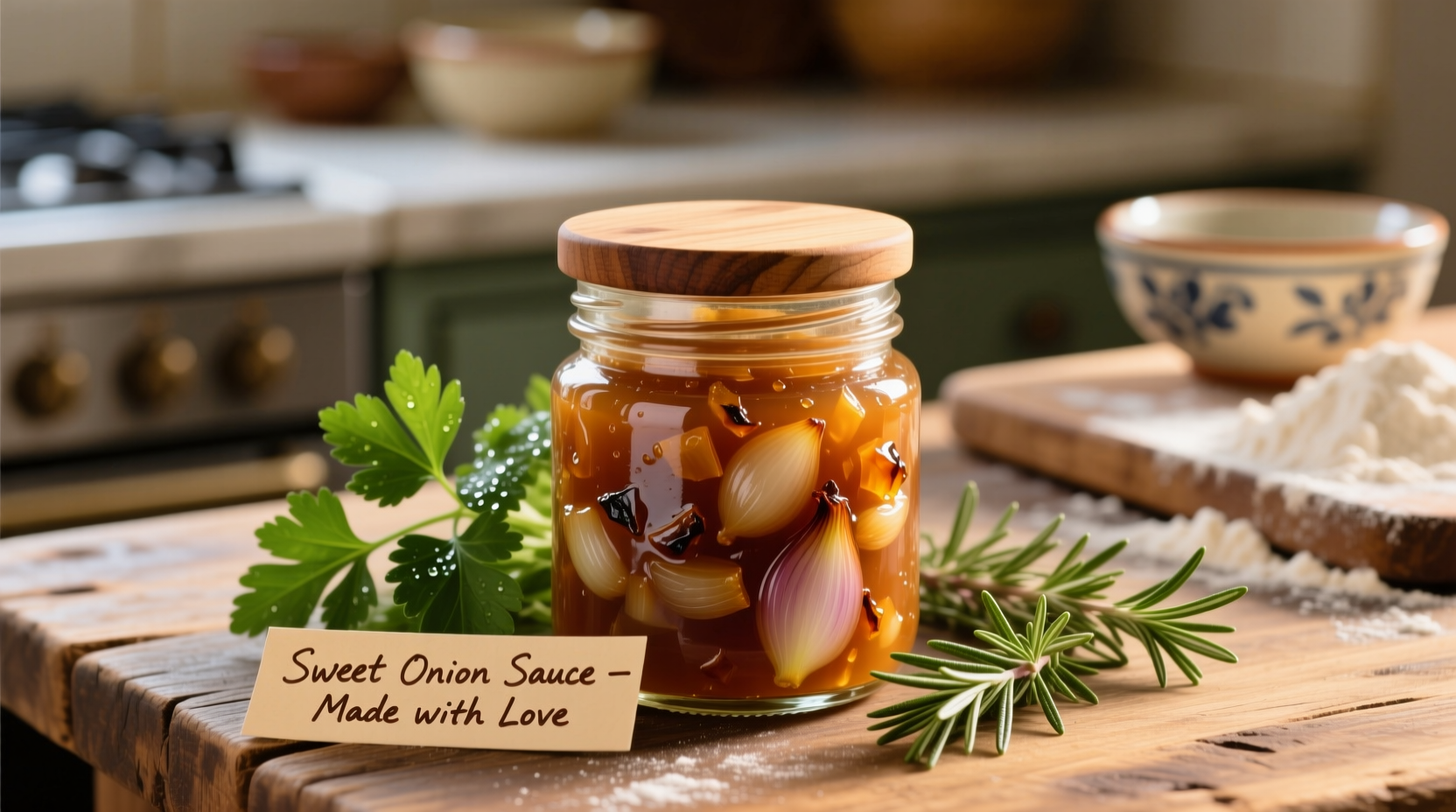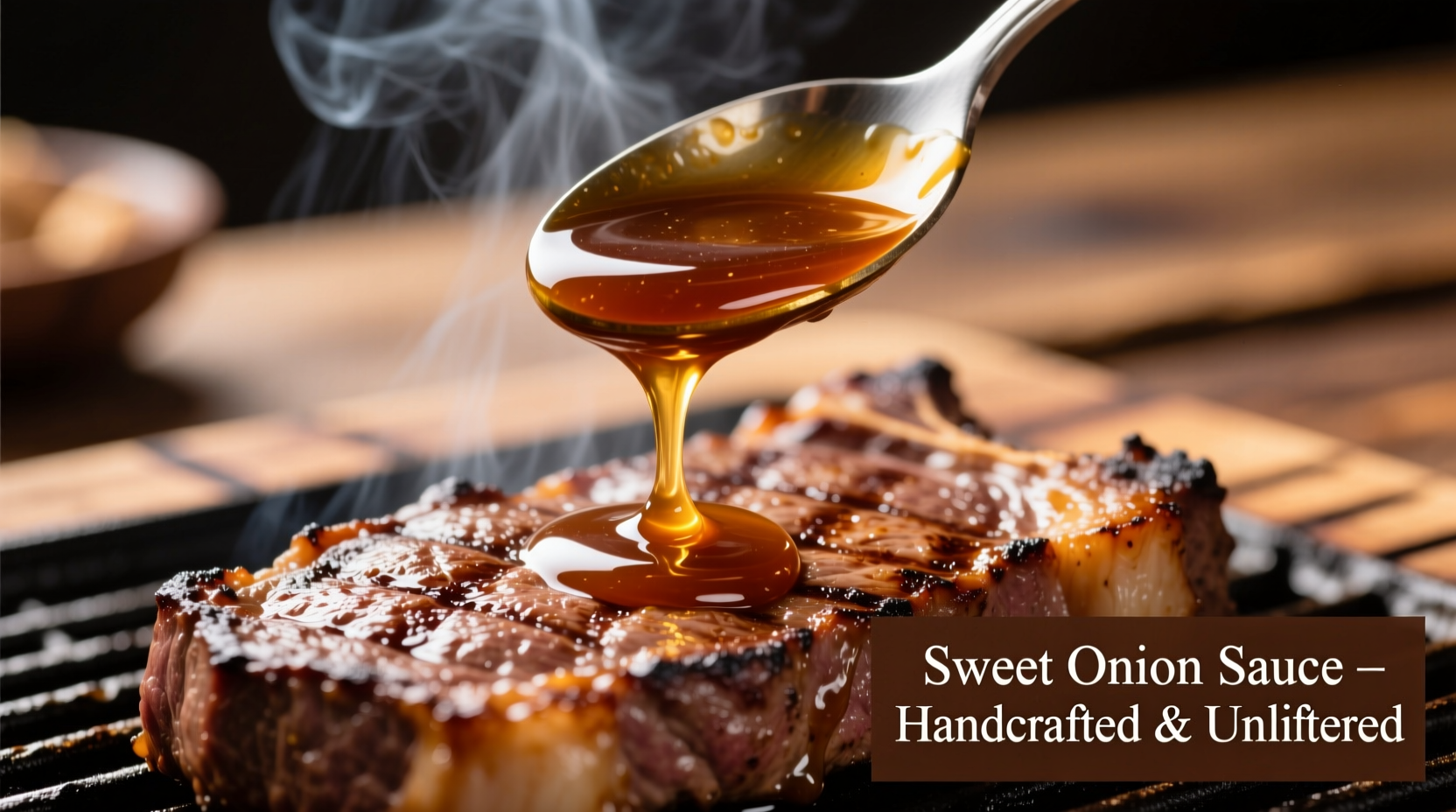Discover why chefs consistently reach for sweet onion sauce when they need to elevate simple dishes without overpowering delicate flavors. Unlike standard barbecue sauces loaded with artificial sweeteners, authentic sweet onion sauce relies on the natural sugars in Vidalia, Walla Walla, or Maui onions that caramelize during slow cooking, creating complex flavor compounds that enhance umami perception in accompanying foods.
The Science Behind Sweet Onion Sauce
When sweet onions cook slowly over low heat, their natural fructose content (approximately 5-6% by weight) undergoes the Maillard reaction and caramelization. This transforms simple sugars into hundreds of flavor compounds including furans and pyrazines that create the sauce's characteristic depth. According to research published in the Journal of Agricultural and Food Chemistry, sweet onions contain lower levels of pyruvic acid (0.1-0.3 μmol/g) compared to yellow onions (6-7 μmol/g), resulting in significantly less pungency and more pronounced sweetness.
| Onion Variety | Sugar Content | Pyruvic Acid Level | Best For Sauce? |
|---|---|---|---|
| Vidalia | 5.5-6.0% | 0.1-0.2 μmol/g | ★★★★★ |
| Walla Walla | 5.0-5.5% | 0.2-0.3 μmol/g | ★★★★☆ |
| Maui | 5.2-5.8% | 0.15-0.25 μmol/g | ★★★★★ |
| Yellow Onion | 4.0-4.5% | 6.0-7.0 μmol/g | ★☆☆☆☆ |
Evolution of Sweet Onion Sauce Through Culinary History
Sweet onion sauce has evolved significantly from its humble beginnings as a regional condiment. Understanding this timeline helps explain why modern versions work so well with diverse cuisines:
- 1930s-1940s: Georgia farmers discovered naturally sweet onions could be preserved with vinegar and sugar, creating early versions of sweet onion relish
- 1950s-1960s: Home economists began incorporating these relishes into barbecue sauces for regional cookbooks
- 1986: Vidalia onions received federal marketing order protection, increasing availability of consistent sweet onion varieties
- 2000s: Professional chefs started using sweet onion marmalade as a sophisticated alternative to traditional onion jam
- Present Day: Food scientists have optimized the sugar-to-acid ratio (typically 3:1) for maximum flavor enhancement without cloying sweetness
Creating Perfect Sweet Onion Sauce: Step-by-Step
Follow this chef-tested method for restaurant-quality results every time. The key is patience during the caramelization phase—rushing this step creates bitter compounds rather than desirable sweet notes.
Essential Equipment
- Heavy-bottomed stainless steel or enameled cast iron pan (avoid non-stick for proper fond development)
- Wooden spoon for stirring
- Immersion blender for smooth texture
Basic Sweet Onion Sauce Recipe
Makes approximately 2 cups | Total time: 1 hour 15 minutes
- Prepare 3 cups thinly sliced sweet onions (about 2 large Vidalias) using a mandoline for consistent 1/8-inch slices
- Melt 2 tablespoons unsalted butter with 1 tablespoon olive oil over medium-low heat
- Add onions and 1 teaspoon kosher salt, stirring to coat evenly
- Cook slowly for 45-50 minutes, stirring every 5-7 minutes until deep golden brown (not burnt)
- Add 1/4 cup apple cider vinegar and deglaze the pan, scraping up all browned bits
- Stir in 2 tablespoons brown sugar and 1/2 teaspoon smoked paprika
- Simmer for 10 minutes until thickened to desired consistency
- Cool slightly and blend to smooth texture using an immersion blender

Optimal Pairings for Sweet Onion Sauce
Understanding which foods complement sweet onion sauce prevents flavor conflicts and maximizes culinary enjoyment. This isn't just a barbecue sauce alternative—it functions as a flavor bridge between sweet and savory elements.
Meat Pairings That Shine
- Pork tenderloin: The sauce's acidity cuts through richness while sweetness complements pork's natural flavor
- Grilled chicken thighs: Creates a balanced profile when used as both marinade and finishing sauce
- Lamb burgers: The allium compounds in onions enhance lamb's distinctive flavor without overwhelming it
Vegan and Vegetarian Applications
- Roasted root vegetables: Drizzle over carrots, parsnips, or sweet potatoes during final roasting minutes
- Mushroom Wellington: Use as a flavorful base layer beneath the pastry
- Grilled portobello mushrooms: Brush on during last 5 minutes of grilling for caramelized perfection
Common Mistakes That Ruin Sweet Onion Sauce
Avoid these pitfalls that turn potentially excellent sauce into a kitchen disaster:
- Using high heat during caramelization: Creates bitter compounds instead of sweet caramel notes. Maintain temperature below 285°F (140°C)
- Adding sugar too early: Causes onions to steam rather than caramelize. Wait until onions have released their moisture
- Over-blending after cooking: Can make sauce gluey. Blend just until smooth, not completely emulsified
- Ignoring acid balance: Without proper vinegar ratio (minimum 1:3 vinegar-to-onion by volume), sauce becomes cloyingly sweet
Customizing Your Sweet Onion Sauce
Tailor your sauce to specific culinary applications with these professional variations:
Dietary Adaptations
- Keto version: Replace sugar with 1-2 tablespoons erythritol and add 1/4 teaspoon xanthan gum for thickness
- Vegan version: Substitute butter with coconut oil and ensure sugar is certified vegan
- Low-sodium version: Reduce salt by 50% and add 1/4 teaspoon celery seed for savory depth
Flavor Variations
- Asian-inspired: Add 1 tablespoon grated ginger and 1 teaspoon sesame oil during final simmer
- Smoky chipotle: Blend in 1-2 minced chipotle peppers in adobo sauce
- Herb-infused: Stir in 2 tablespoons chopped fresh thyme or rosemary during last 5 minutes of cooking
Storage and Shelf Life Guidelines
Proper storage maintains both safety and flavor quality. Sweet onion sauce contains enough acid (pH 3.8-4.2) to prevent bacterial growth when stored correctly:
- Refrigeration: Store in airtight container for up to 2 weeks
- Freezing: Portion into ice cube trays, then transfer to freezer bags for up to 6 months
- Canning: Process in water bath for 15 minutes for shelf-stable storage up to 1 year (pH must be verified below 4.6)
Always use clean utensils when serving to prevent contamination. Discard if you notice mold, off-odors, or significant separation that doesn't reincorporate with stirring.











 浙公网安备
33010002000092号
浙公网安备
33010002000092号 浙B2-20120091-4
浙B2-20120091-4